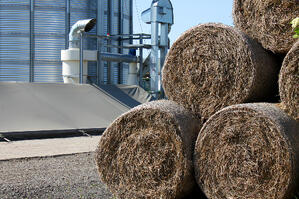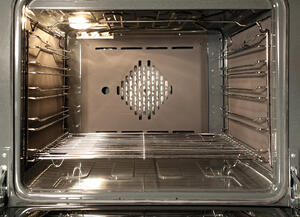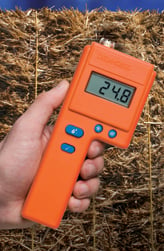 Before a hay bale can be ensiled or otherwise stored for later use, it needs to have the right moisture content. Too wet, and the hay may develop mold or even combust in the silo. Too dry, and the hay loses much of its nutritive value as feed for farm animals. For this reason, it is important to be able to accurately assess the amount of moisture in a hay bale when getting ready to store it.
Before a hay bale can be ensiled or otherwise stored for later use, it needs to have the right moisture content. Too wet, and the hay may develop mold or even combust in the silo. Too dry, and the hay loses much of its nutritive value as feed for farm animals. For this reason, it is important to be able to accurately assess the amount of moisture in a hay bale when getting ready to store it.
But, how do farmers measure the moisture content of their hay bales before putting them into the silo?
As it turns out, there are several methods that farmers employ to test the moisture content of their hay. Each moisture testing method has its own benefits and drawbacks, which we’ll talk about here.
Method #1: By Hand
One of the oldest methods by which farmers have assessed the moisture content and quality of their produce. This method has been around for longer than any other, mostly because it doesn’t require any other tools than your own two hands.
In this method, a farmer simply takes a bundle of hay out of the bale and twists or squeezes it in his or her hands. The farmer then releases the hay and sees how it reacts. The farmer estimates how much water came out of the bundle and whether the hay holds its new shape, unfolds normally, or breaks.
There are a lot of problems with this method, including that:
- It takes years of experience in handling hay to be able to make even a rough assessment of the bale’s moisture content based on feel alone.
- Even with experience, a single, fist-sized sample of the hay bale may not be representative of the moisture content of the overall hay bale. This is especially true since such samples are typically taken from near the surface of the bale, where the hay will be more significantly affected by the weather.
However, for a rough guess of the moisture content of a bale when no other tools are available, this method might suffice for an extremely experienced farmer. It is not, however, generally recommended as a primary method for moisture testing.
Method #2: Oven Drying Tests
 There are several different kinds of oven dry tests, each one assuming a different kind of oven/heating element. For example, there are variations of the oven dry test for convection ovens, microwave ovens, and even in-field testing apparatuses.
There are several different kinds of oven dry tests, each one assuming a different kind of oven/heating element. For example, there are variations of the oven dry test for convection ovens, microwave ovens, and even in-field testing apparatuses.
No matter which kind of oven that is used in the test, the process for determining the moisture content of the hay remains largely the same:
- Measure the weight of the hay sample before drying.
- Dry the hay (this can take 20-40 minutes, depending on drying method and overall moisture of the hay). In some cases, it may be necessary to repeat the drying process until the weight of the hay sample stops changing.
- Weigh the dry hay to determine the “dry weight.”
- Divide the dry weight by the wet weight, and convert to a percent number. Subtract this number from 100 to get your moisture content percentage.
An example of the dry/wet equation if you had hay that weighed 200 grams before drying and 150 grams after drying would be: 150 ÷ 200 = .75, or 75% dry weight, which means that the %MC of the hay is 25%.
This method can perhaps be considered one of the most accurate methods of determining the exact moisture content.
The problem? It can take hours or even days for moisture testing to complete in some cases. For example the convection oven drying method has you drying out the sample for 24 hours at a temperature of 165 °F. With hay that is already baled, time might not be a huge factor, unless it rains while you’re waiting for the results, in which case your previous measurements become worthless.
Also, in order to get a sample size large enough to be considered a reliable measure of the moisture of your hay bales, you would have to take several samples from each bale, which may be impractical when you’re making hundreds of hay bales in a day.
Method #3: Moisture Probes for Hay
 If measuring moisture by hand is too inaccurate to be useful, and using the oven-dry test takes too long, what is the best way to get a fast, reliable moisture measurement in hay bales? Is there a testing method that provides a reasonable balance between accuracy and immediacy?
If measuring moisture by hand is too inaccurate to be useful, and using the oven-dry test takes too long, what is the best way to get a fast, reliable moisture measurement in hay bales? Is there a testing method that provides a reasonable balance between accuracy and immediacy?
Actually, there is a method that provides both a fast measurement speed (even faster than hand measurements) and a reasonable degree of accuracy: hay moisture probes.
These rugged and reliable devices come in many varieties, from baler-mounted units that can measure moisture as the hay is being baled to portable units that farmers can carry with them to double-check moisture in hay bales before storing them.
Simply stick the probe in the hay bale, turn it on, and it will start testing the hay for you. Certain models of moisture meters can even take multiple readings per second, allowing you to average the results quickly. Delmhorst’s own F-2000 series will average up to 100 accumulated readings for you, ensuring that your moisture readings won’t be thrown off by a fluke.
With the speed at which a moisture meter can test a hay bale, verifying your initial results is the work of a few moments, not hours. This allows moisture meters to be a valid way to measure moisture when preparing the hay for baling as well, since there are often only a few hours in which hay will be at the ideal moisture content for baling.
Overall, moisture meters are a fast and effective way to test the moisture of hay bales, combining the benefits of fast measurements with accuracy to give farmers a reliable measurement when time is of the essence.

Comments